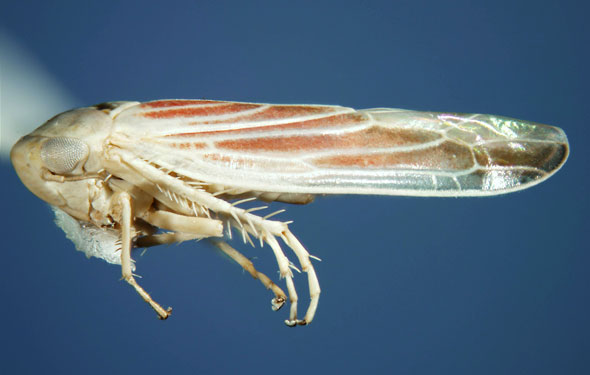SHSU Researchers Working To Prevent Insect�s Impact On Sugarcane Industry
Feb. 2, 2012
SHSU Media Contact: Julia May
 |
| Although somewhat attractive with its colorful wings, the red-streaked leafhopper could wipe out an entire agricultural industry. Researchers at SHSU are working to keep that from happening. — Photo from the SHSU Department of Biological Sciences |
The discovery of an insect in Texas that could have devastating effects on the United States’ sugarcane industry has attracted the attention of researchers at Sam Houston State University in Huntsville.
The invasive Balclutha rubrostriata, or red-streaked leafhopper, has been found in the San Antonio area, and its damaging tendencies have been well documented in Southeast Asia and Australia, according to Jerry Cook, an entomologist who also serves as associate vice president for research at SHSU.
Cook is one of more than 40 scientists throughout the Texas State University System working through the Institute for the Study of Invasive Species, located at Sam Houston State, to study and develop strategies to deal with invasive species across the state.
In Texas, sugarcane is produced in the lower Rio Grande Valley, where the economic impact exceeds $200 million and provides several hundred permanent jobs in a region where employment opportunities are well below the state average.
The United States ranks third in the world in sugar consumption. Along with Texas, sugarcane is grown commercially in Florida, Hawaii, and neighboring Louisiana, where it ranks first in the state among plant commodities.
“If the leafhopper becomes established in Texas, it won’t be long until Louisiana feels its damaging effects as well,” said Cook.
Leafhoppers have piercing and sucking mouthparts, which they use to extract the sap from sugarcane.
“That’s how they feed,” said Cook. “If there is a heavy infestation, it can kill the plant.”
However, even without feeding on the plant, the leafhopper can do considerable damage by transmitting diseases that decrease the plant’s fitness.
“Those diseases might not destroy the plant, but they would substantially reduce the yield of the crop,” he said. “On the other hand, there is a particular virus leafhoppers have carried in Southeast Asia and Australia, and it has wiped out entire crops.”
The leafhopper’s existence in Texas was discovered by accident during a routine study in Bexar County in 2008.
“The entomologists had traps set out to collect lots of different types of insects, and they were looking for certain ones that were already identified,” said Cook. “They deposited the specimens in a collection in an entomology museum. An expert who studies leafhoppers later came through, just to look at the collection. He immediately recognized that this particular one shouldn’t be there.”
Cook read about the discovery in the professional journal “Entomological News,” which was published last year.
“As soon as I read the article, I knew it was not a good thing to have this species in our state,” he said.
As a strong proponent of “early detection/rapid response” for managing invasive species, Cook assembled his research team of biology professor Autumn Smith and biology graduate student Chris Wilson and began making plans for a full-scale study.
“It’s one of the tenets of the Institute for the Study of Invasive Species,” Cook said. “A lot of people talk about early detection and rapid response being critical to working with invasives, but very few groups are doing that. Most of what is done is very reactionary. We only start putting resources into it when it becomes a giant problem.
“If we can find these species early before they are out of control, make a management response, and hopefully eradicate them, then they will never become an economic problem,” Cook said. “With the red-streaked leafhopper alone, we can prevent up to a $200 million loss in Texas and a $1.2 billion loss in Louisiana and potentially save an industry.”
SHSU will again survey the insects around the San Antonio next month.
“The timing coincides with the leafhopper life cycle,” Cook said. “About mid-February, as temperatures begin to warm, the eggs that were laid the previous year start hatching. But the insects are so small right at first, it’s March before we can begin to discover them.”
Depending on how extensive the study turns out, partners at the other institutions in the Texas State University System will become involved.
The timing for SHSU’s research is especially good for sugarcane producers in Texas. Later this year, the U. S Department of Agriculture is closing the Kika de la Garza Subtropical Research Center in Weslaco, which has been responsible for conducting research on crops and agriculture imports from Mexico and Central America.
“The one resource the sugarcane growers in that area have been using is going away,” Cook said.
- END -
This page maintained by SHSU's Communications Office:
Associate Director: Julia May
Manager: Jennifer Gauntt
Located in Administration Building Suite 115
Telephone: 936.294.1836; Fax: 936.294.1834
Please send comments, corrections, news tips to Today@Sam.edu.

 SamWeb
SamWeb My Sam
My Sam E-mail
E-mail

